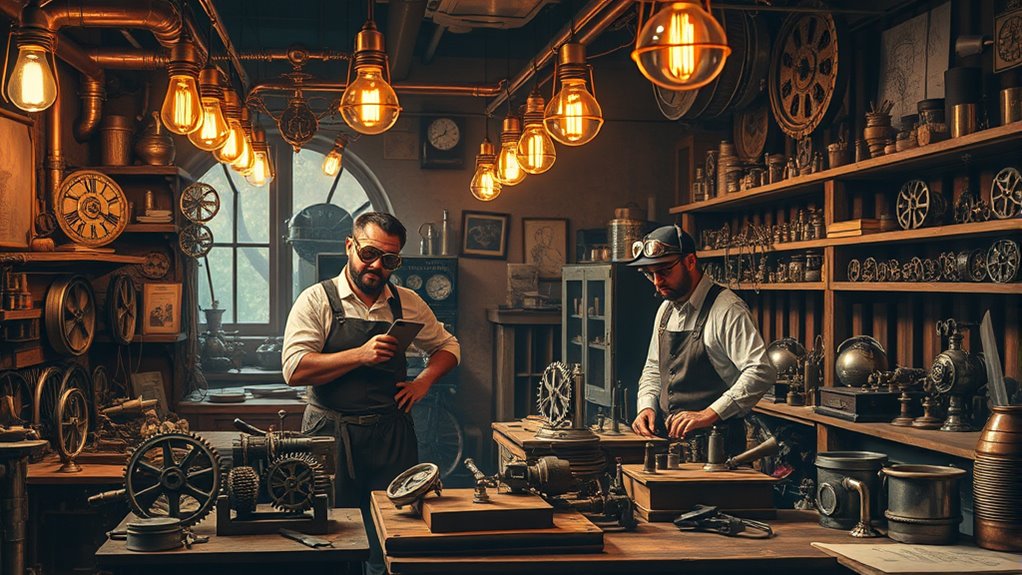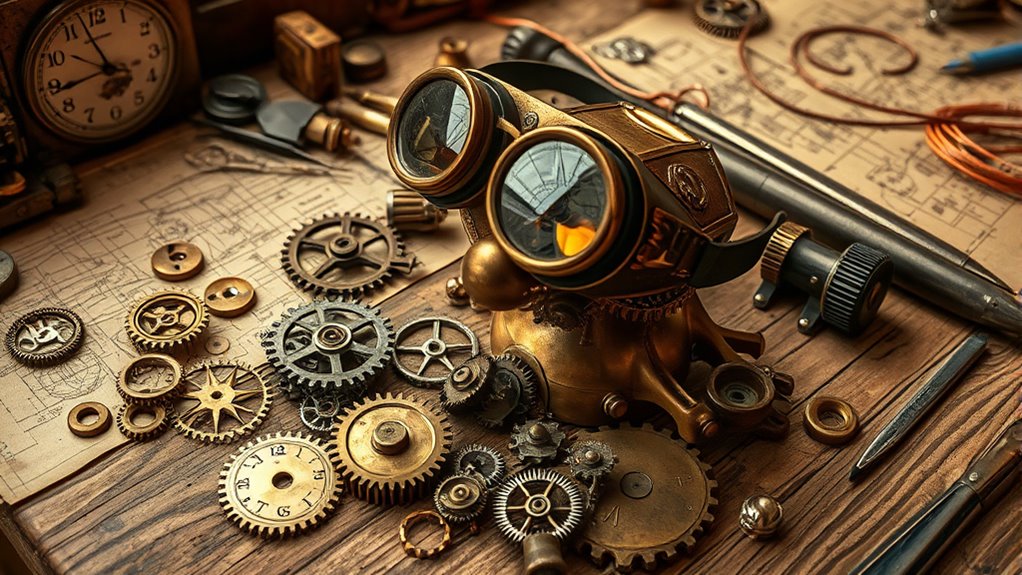If you’re inspired by Victorian aesthetics and craftsmanship, you can turn that passion into a profession by becoming a steampunk artisan. Many artisans craft unique accessories, clothing, and home decor by applying traditional techniques like soldering and leatherworking. They focus on quality, authenticity, and storytelling, which sets their handmade goods apart from mass-produced items. If you want to explore how these passionate creators transform their love for craftsmanship into a thriving cottage industry, there’s much more to discover.
Key Takeaways
- Many steampunk artisans turn their passion for Victorian aesthetics into professional handcrafted businesses.
- The cottage industry allows artisans to maintain authenticity and personalized craftsmanship outside mass production.
- Traditional techniques like soldering and leatherworking are vital in creating genuine, high-quality steampunk pieces.
- Inspiration from Victorian ornate details and eco-friendly materials shapes unique, creative designs.
- Dedication, patience, and storytelling are core values driving artisans from hobbyists to professional creators.

Have you ever wondered how the vibrant world of steampunk craftsmanship thrives outside mass production? It’s a fascinating scene where passion transforms into a livelihood, and artisans breathe new life into Victorian aesthetics through handmade craftsmanship. These creators aren’t just producing goods; they’re reviving a style that marries the elegance of the 19th century with a gritty, industrial appeal. You can see this in their meticulously crafted accessories, clothing, and home decor, each piece a unique proof to their skill and love for the genre. Unlike factory-produced items, these works carry a personality and history that mass-market goods can’t replicate, making each item special and deeply rooted in the steampunk ethos.
As you explore this cottage industry, you’ll notice how artisans dedicate themselves to perfecting their craft. They often start as enthusiasts, drawn by the allure of Victorian aesthetics and the challenge of creating authentic-looking pieces. Over time, this passion deepens, and what began as a hobby evolves into a full-fledged profession. Their work is characterized by an attention to detail that can only come from handmade craftsmanship. Every gear, every brass embellishment, and every leather strap is carefully assembled, often by hand, reflecting a commitment to quality that’s hard to find in mass production. This personal touch ensures that each item has its own story, its own character, distinguishing it from the uniformity of factory-made goods.
These artisans often draw inspiration from historical designs, blending them with their own creative twists. They use traditional techniques—like soldering, leatherworking, and metal casting—preserving skills that might otherwise fade away. This approach not only keeps the craftsmanship alive but also allows for customization, giving customers one-of-a-kind pieces that resonate with their individual style. Their work embodies a harmony between Victorian aesthetics—think ornate details, intricate patterns, and a nostalgic elegance—and modern functionality. This melding of old and new is what makes their creations stand out. Additionally, understanding raw food diets can inspire artisans to incorporate natural materials and eco-friendly practices into their work, aligning with the values of sustainability and authenticity that many steampunk enthusiasts appreciate.
In the cottage industry, passion and patience are key. You’ll find that these artisans pour hours into each project because they believe in making authentic, handcrafted pieces that reflect their love for steampunk. They thrive outside the confines of mass production, driven by a desire to maintain the integrity of their craft and keep the spirit of Victorian aesthetics alive. It’s a world where craftsmanship isn’t just a skill but a form of artistic expression—one that invites you to appreciate the beauty of handmade, one-of-a-kind items that tell a story of passion turned profession.
Frequently Asked Questions
How Do Steampunk Artisans Finance Their Startup Costs?
You can finance your startup costs through various fundraising strategies like crowdfunding campaigns on platforms such as Kickstarter or Indiegogo. Seek grants and sponsorships from arts organizations or local businesses that support creative entrepreneurs. Additionally, you might tap into personal savings or take small business loans. Combining these methods helps you gather the necessary funds to launch your steampunk artisan venture effectively and sustainably.
What Are the Best Platforms for Selling Steampunk Crafts?
Imagine your steampunk creations as treasures waiting to be discovered. To showcase them, you should explore online marketplaces like Etsy and eBay, where a global crowd searches for unique crafts. Don’t forget craft fairs—they’re like bustling markets filled with fellow explorers. These platforms help you connect with enthusiasts, boost your visibility, and turn your passion into a thriving business. Start your journey today and watch your steampunk world flourish!
How Do Artisans Protect Their Unique Designs Legally?
To protect your unique designs, you should focus on your intellectual property rights. Consider registering trademarks for your brand to prevent others from copying your name or logo. Additionally, explore copyright protection for your original artwork and designs. Keep detailed records of your creation process, and consult a legal expert to make sure you’re taking the right steps. These measures help safeguard your work and establish your ownership in the marketplace.
What Skills Are Essential for Aspiring Steampunk Artisans?
You need a solid grasp of crafting techniques and material sourcing to become a successful steampunk artisan. Mastering these skills allows you to create unique, high-quality pieces that stand out. Focus on learning different techniques for metalwork, leather, and clockwork assembly. Develop an eye for sourcing authentic materials, and stay updated on trends. These skills help you innovate and build a distinctive style, essential for thriving in the steampunk craft community.
How Do Steampunk Artisans Stay Updated With Industry Trends?
Think of staying updated as riding a dynamic wave through a bustling sea. You keep your balance by engaging in industry networking, connecting with fellow artisans, and attending events. Trend forecasting acts as your compass, guiding you toward emerging styles. By actively participating in online forums, social media, and trade shows, you stay in sync with the latest innovations, ensuring your steampunk creations remain fresh and enthralling.
Conclusion
You might think passion alone fuels steampunk artisans, but evidence suggests a deeper truth: their craft often transforms into a sustainable cottage industry. By turning creativity into a profession, they challenge the idea that art must be purely hobby. This blend of passion and entrepreneurship proves that with dedication, you can turn your love for steampunk into a fulfilling livelihood—making the theory of art as a true profession not just possible, but thriving.









